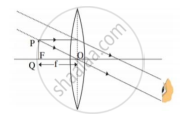Advertisements
Advertisements
प्रश्न
Find the nature, position and magnification of the images formed by a convex lens of focal length 0.20 m if the object is placed at a distance of:
0.15 m
उत्तर
u = -15 cm
f = 20
Substituting these values in the lens formula, we get:
`1/f=1/v-1/u`
`1/20=1/v-1/-15`
`1/20=1/v+1/15`
`1/20-1/15=1/v`
`1/v=(3-4)/60`
`1/v=-1/60`
v=-60 cm
The image will be formed at a distance of 60 cm in front of the mirror.
`m=v/u`
⇒`m=(- 60)/-15`
⇒m=4
Magnification is positive; therefore, the image is virtual and
erect.
APPEARS IN
संबंधित प्रश्न
Draw a ray diagram to show the formation of image in the above situation
Draw a ray diagram to show the formation of a real magnified image by a convex lens. (In your sketch the position of object and image with respect to the principal focus of lens should be shown clearly).
Describe with the help of a ray diagram the nature, size and position of the image formed when an object is placed in front of a convex lens between focus and optical centre. State three characteristics of the image formed.
How could you find the focal length of a convex lens rapidly but approximately?
With the help of a labelled diagram explain how a convex lens converges a beam of parallel light rays. Mark the principal axis, optical centre, principal focus and focal length of the convex lens on the diagram.
The diagrams (a) and (b) in Figure below show the refraction of a monochromatic ray of light through a parallel sided glass block and a prism respectively. In each diagram, label the incident, refracted emergent rays and the angle of deviation.

Answer the following question.
List four precautions which a student should observe while determining the focal length of a given convex lens by obtaining an image of a distant object on a screen.
_______ is a combination of two convex lenses with small focal length.
 : Object near the lens : : ______ :
: Object near the lens : : ______ : 
